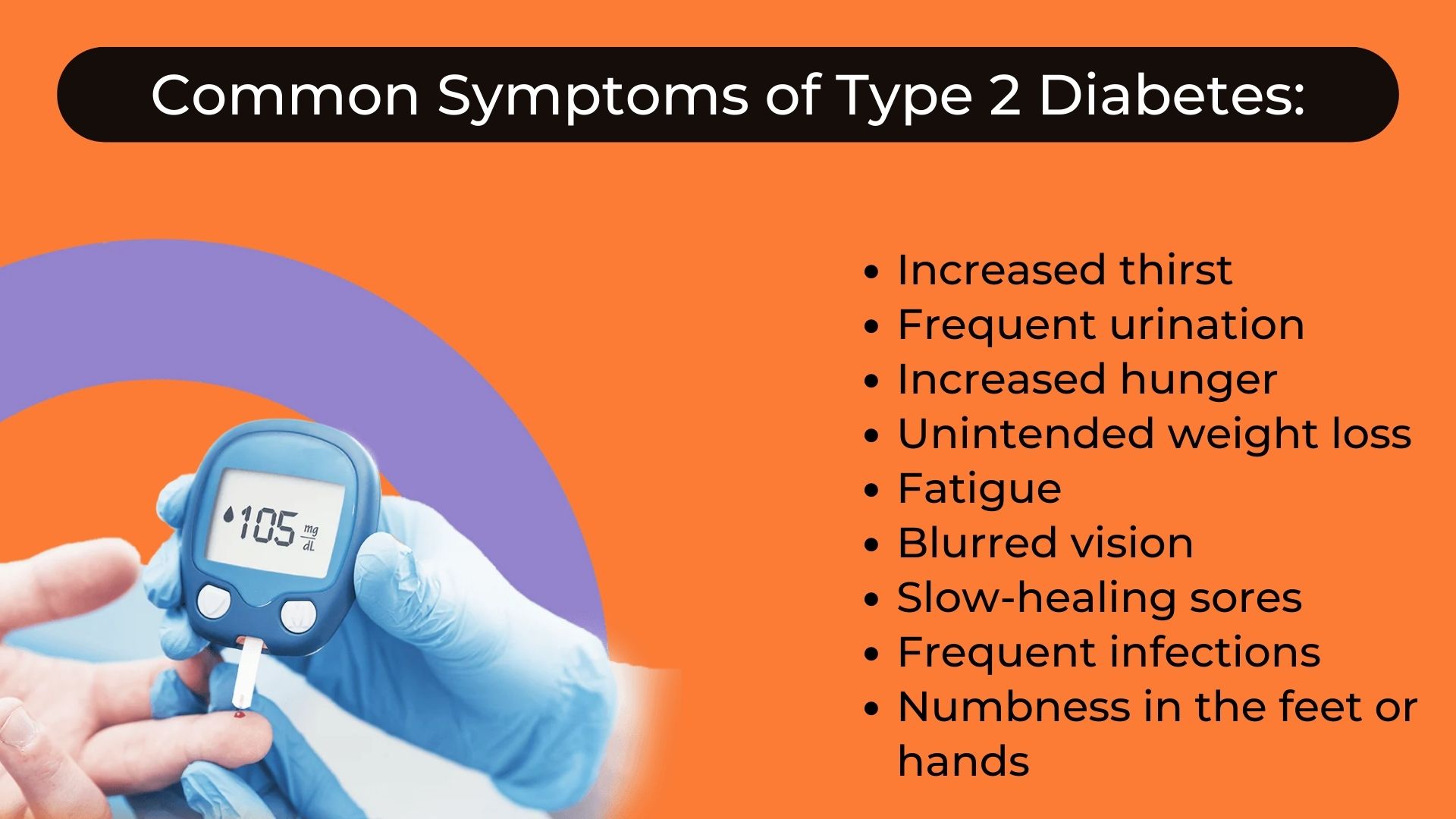
Type 2 diabetes (Diabetes Mellitus) is the most common form of diabetes, generally characterized by insulin resistance. In this disease, a person’s body fails to properly respond to insulin which gives rise to blood glucose levels.
If this form of diabetes is left untreated for prolonged periods, it can lead to various health problems, including kidney diseases, cardiovascular problems, and stroke.
However, this disease can be managed with the help of medications, lifestyle changes, and regular checkups by your healthcare provider.
In this article, we will discuss everything you need to know about diabetes mellitus. This will help you manage your symptoms and lead a healthier life.
Symptoms:
Symptoms and indicators of type 2 diabetes may develop over time. In some cases, it can be present in patients for years without their knowledge.
The most common symptoms of this condition usually include:
- Increased thirst.
- Frequent urination.
- Increased hunger.
- Unintended weight loss.
- Fatigue.
- Blurred vision.
- Slow-healing sores.
- Frequent infections.
- Numbness in the feet or hands.

Causes:
There are several factors that can contribute to the development of type 2 diabetes, including:
- Genetics: It can run in families, and some people may be more genetically predisposed to developing the condition.
- Lifestyle factors: Being overweight or obese, having a sedentary lifestyle, and eating a diet high in processed and sugary foods can increase your risk of developing type 2 diabetes.
- Age: As you get older, your risk of developing type 2 diabetes increases.
- Medical Conditions: Certain medical conditions, such as polycystic ovary syndrome (PCOS), high blood pressure, and high cholesterol, can increase your risk of developing type 2 diabetes.
Testing For Type 2 Diabetes:
It is usually diagnosed by different types of tests depending on the severity of the condition.
Some common forms of diagnosis for type 2 diabetes are:
1. A1C Test
The glycated hemoglobin (A1C) is a simple test that measures your blood glucose levels. This test provides information about your average levels of blood sugar over the past 2 to 3 months.
2. Glucose Tolerance Test
It is a lab test that evaluates an individual’s insulin sensitivity. It simply measures how well your body processes sugar from the blood into tissues like muscle and fat.
In this test, patients are advised to fast overnight before and have their blood drawn to determine their fasting blood sugar level.
3. Random Blood Sugar Test
If someone has severe symptoms of diabetes, he can have a random blood sugar test at any time without fasting. This is a very easy test that gives immediate results.
In random blood sugar tests, blood is usually drawn through a finger or a vein in the patient’s arm. A blood sugar level of 200 mg/dL or higher tells that a person might have diabetes.
Medications for Type 2 Diabetes
The primary goal of diabetes treatment is to help a patient’s body use insulin better or to get rid of extra glucose in the blood.
Most medications used in the treatment of type 2 diabetes are oral drugs. However, some healthcare providers also prescribe insulin or injectables to their patients.
Some of the medications for type 2 diabetes are combinations of more than one drug:
1. Metformin
Metformin is a biguanide medication that effectively helps lower blood glucose levels by reducing the amount of glucose produced by the liver.
This medication also helps decrease blood sugar levels by making muscle tissues more sensitive to insulin.
2. Meglitinides
Type 2 diabetics can also take insulin. However, insulin is more commonly prescribed as a treatment option for patients suffering from type 1 diabetes. But if a patient has type 2 diabetes for prolonged periods, he will more likely require insulin.
Healthcare providers may recommend different types of insulin used in type 1 diabetes treatment for patients having type 2 diabetes.
3. Insulin
Type 2 diabetics can also take insulin. However, insulin is more commonly prescribed as a treatment option for patients suffering from type 1 diabetes. But if a patient has type 2 diabetes for prolonged periods, he will more likely require insulin.
Healthcare providers may recommend different types of insulin used in type 1 diabetes treatment for patients having type 2 diabetes.
Management of Type 2 Diabetes
People can manage their diabetes symptoms with various types of lifestyle changes and by following their doctor’s advice. If left unattended, the excess sugar in your blood can eventually cause problems and result in severe health complications.
You can manage type 2 diabetes by:
- Eating healthy meals.
- Indulging yourself in regular physical activities.
- Regularly monitoring your blood sugar levels.
- Maintaining a healthy body weight.
- Taking diabetic medications daily.
- Managing stress.
Life does not end with diabetes type 2; every person’s journey is unique and starts fresh every day. No matter where you are with type 2 diabetes, by following the above-mentioned management tips, you can live a healthier and entirely normal life.
However, the type of treatment for this disease usually varies from person to person. Some people can control their blood glucose levels with healthy eating and physical activities. Whereas others might need to take regular medications to manage it.
Risk Factors of Type 2 Diabetes
The following are hazard factors for type 2 diabetes:
1. Fat Distribution:
Fat distribution can play a significant role in the development of type 2 diabetes. This is because excess fat, particularly around the abdomen, can cause the body to become resistant to insulin, a hormone that regulates blood sugar levels.
When fat cells accumulate around the abdomen, they release hormones and other substances that can interfere with insulin’s ability to regulate blood sugar.
This leads to a condition known as insulin resistance, where the body needs more insulin than usual to keep blood sugar levels in check.
2. Inactivity:
The less active you are, the higher your risk is. Exercise helps you lose weight because it makes your cells more sensitive to insulin and helps them burn glucose for energy.
3. Family History
Your risk of getting type 2 diabetes increases if your parents or siblings already have it.
FAQs:
What is Type 2 Diabetes ICD 10?
ICD-10 code for Type 2 diabetes mellitus is a medical code that reflects the appropriate diagnosis for uncontrolled type 2 diabetes without complications.
Is Type 2 Diabetes Very Serious?
If diabetes mellitus is left untreated for extended periods, it can cause various health problems, such as hypertension, narrowing of blood vessels, organ failure, nerve damage, cardiovascular problems, and stroke.
However, this disease can be successfully managed with the help of medications and certain lifestyle changes.
Can Type 2 Diabetics Live a Long Life?
People suffering from type 2 diabetes can live a long and completely healthy life by meeting their treatment goals.
Life expectancy for people suffering from it can be increased by 3 years or, in some cases, as much as 10 years with proper care and medications.
Can Type 2 Diabetes Be Delayed?
You can certainly prevent or delay type 2 diabetes with the help of the aforementioned lifestyle modifications.
These changes will also help you maintain a healthy weight and will also reduce your likelihood of developing other diseases.